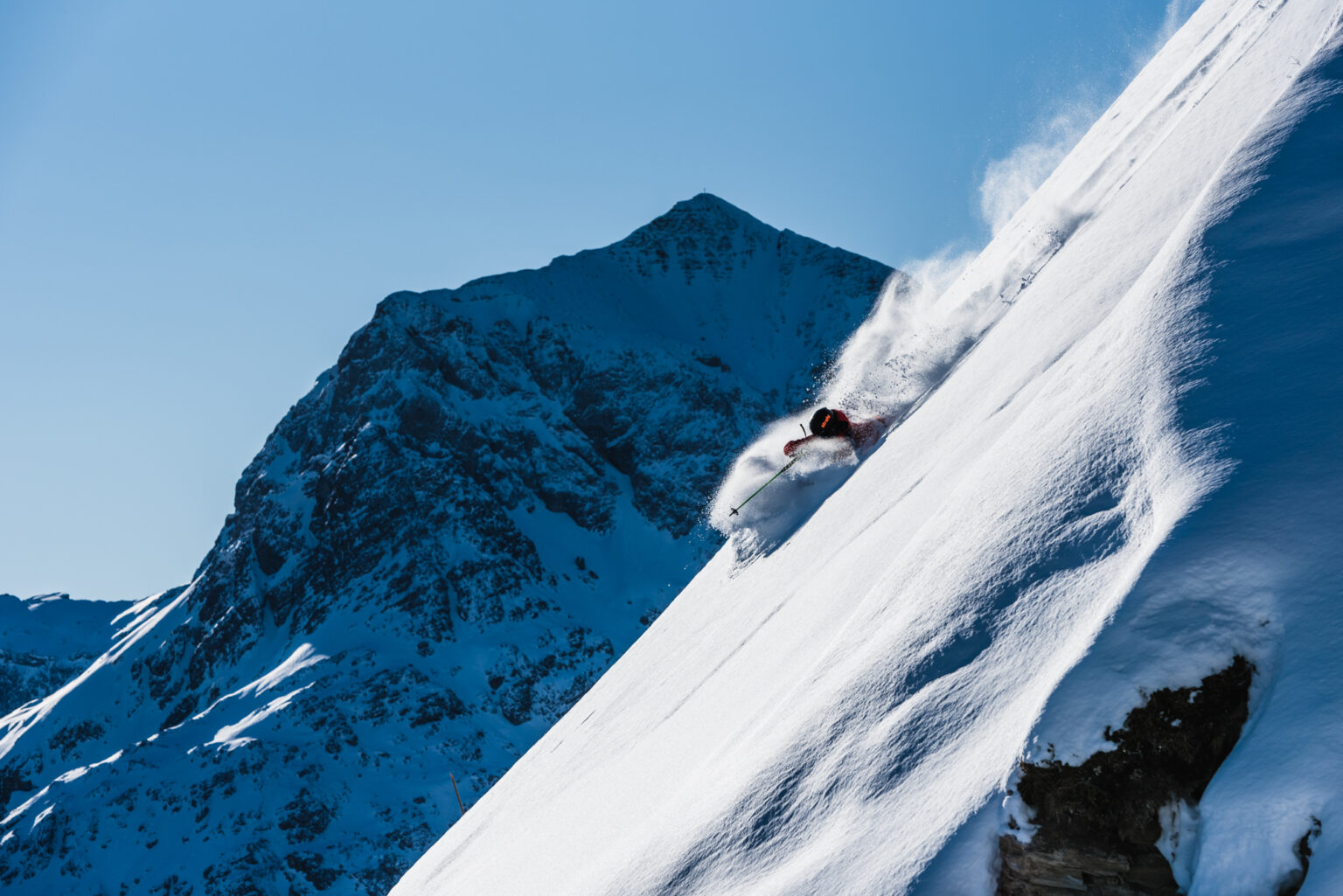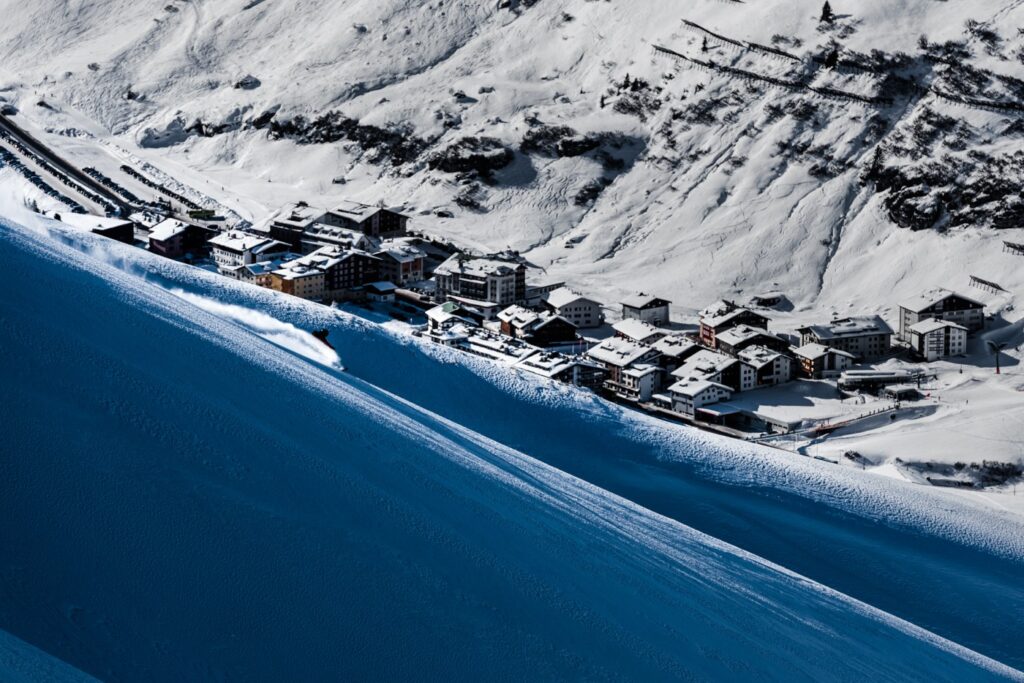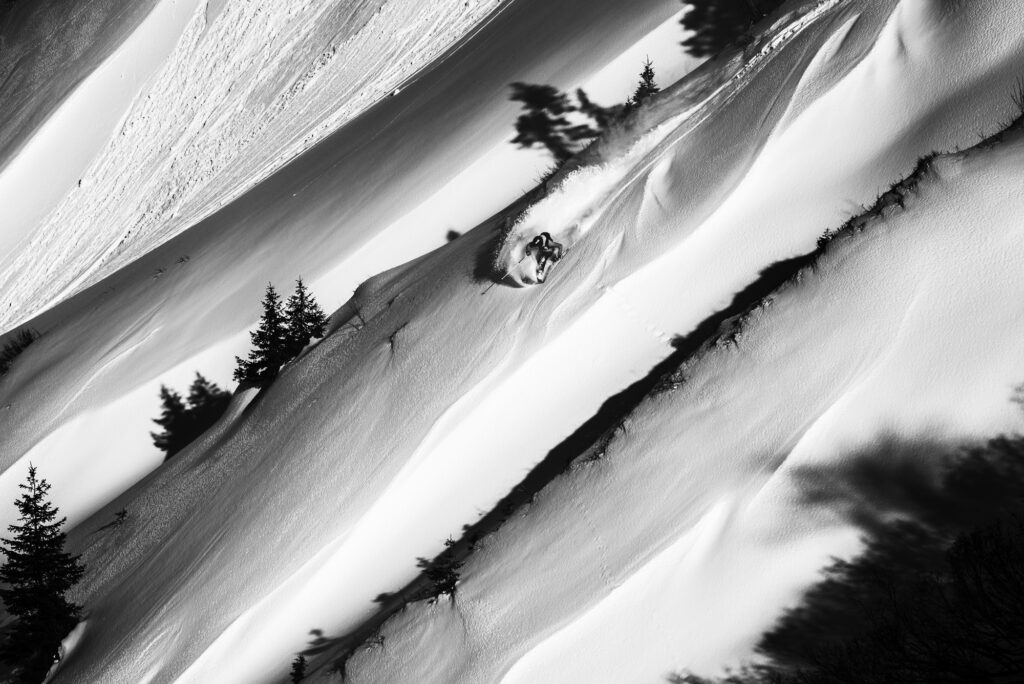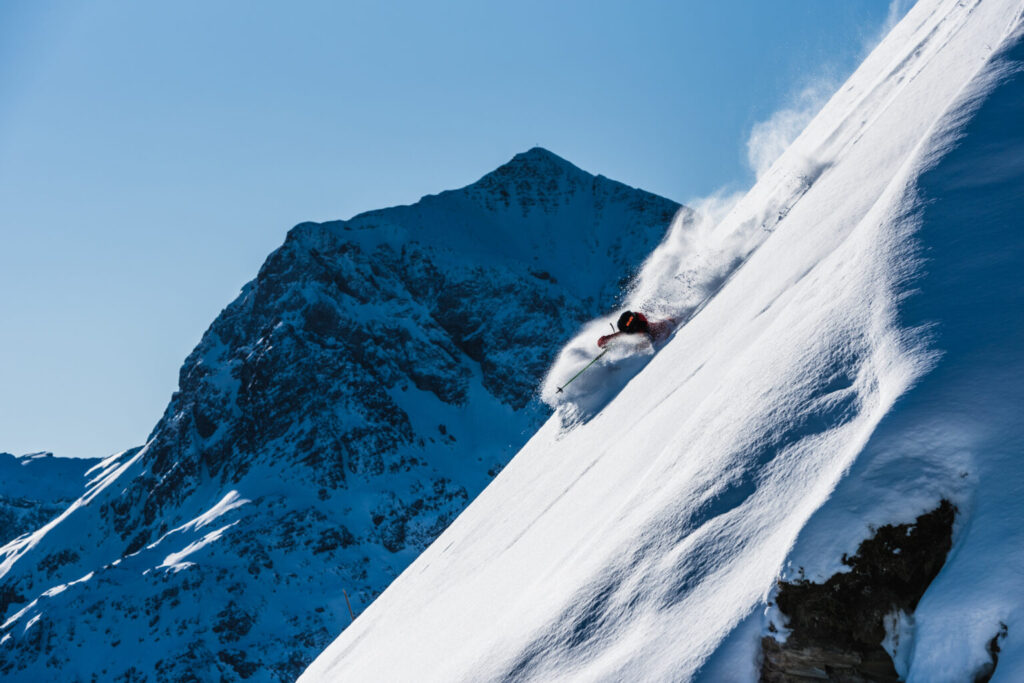In Search of Powder | Lech
CONCEALED ABOVE THE GLITZY HOTELS AND MELLOW PISTES OF THIS AUSTRIAN MEGA RESORT IS SOME THRILLING OFF-PISTE TERRAIN, FINDS AXEL ADOLFSSON AS HE HEADS OFF IN SEARCH OF POWDER IN LECH


WORDS AND PHOTOS AXEL ADOLFSSON
A Mercedes G63 rumbles past us on the main street, its reflection gleaming in the vast windows of the Rolex store. In front of us there’s a Porsche Panamera with a roof box parked outside the grocery store. Our guide, Edi, points towards a gathering of wooden houses further up the hillside. “Do you see up there? Those houses are Oberlech. That’s where Princess Diana used to stay when she was in town for her ski holidays. These days you might catch sight of the Dutch royal family, they’re regulars here.”
It requires a certain level of living standard to go on a ski holiday. Though, of course, some resorts are fancier than others. Lech, situated next to the Arlberg massif in Austria, is about as fancy as they come. A village where the price of an overnight stay can match the cost of an entire week in a mountain cabin attracts a certain type of clientele. Fur collars and cars well above the average Joe’s budget – these are the people who frequent Lech.
And let me tell you, these people are in a hurry. Sharp elbows are helpful while waiting for the cable car here. On the second day a man sneaks up from behind me, and before I can blink, pushes himself past. Taken by surprise, all I can manage is to throw him a bewildered, questioning look. My fellow traveller has just sneaked two spots forward in the queue in order to… well, whoever can give me the answer to that question I would be most grateful.
The pointlessness of his actions, combined with the inexplicable desire of all the other cabin passengers to be first at any cost, leaves me frustrated. News flash: you won’t be able to ski that much more corduroy despite your lift queue manoeuvres. Because after a visual inspection of the skis around me, I can conclude that groomed slopes is what most of these people will be skiing today. Good, my life as a freeride ski photographer just got a little easier.
Let’s start from the beginning. In late autumn I was texting back and forth with Salomon’s new ski star, Lovisa Rosengren, to find out what destinations could make for an exciting ski story for next winter. Lovisa told me that Lech is a good place for freeriders. Very good. Yet it is considerably off-the-radar compared with some of its fellow Arlberg resorts. It also one of the most snow-abundant ski areas in Europe – snowier, in fact, than its neighbour St Anton – and concealed above the glitzy hotels and mellow pistes is some thrilling off-piste terrain.
So it was decided – to Lech we would go. We asked Lovisa’s friend Felix Dilli to be part of our team to help with local knowledge. Having spent the past six winters in the Arlberg area, Dilli knows most of what there is to know about skiing in Lech. Felix accepted, and the group was formed.

After a frustrating start, day two soon takes a turn for the better, and we find some awesome untouched fresh snow in the forest just a few yards from the lavish wooden houses in Oberlech, which is situated on the western slope from the village.
Our good fortune then continues with us meeting up with our guide, Edi. As we get off the Schlegelkopf lift for our second run, Edi barely has a chance to give us directions on where to go before Lovisa and Felix have found more areas of fresh powder. And it just keeps repeating.
Eventually, Edi gives us some advice, and we move away from Lech towards the Saloberkopf mountain. Looker’s right from the Sonnen-Jet lift, which skirts the peak, Edi shows us a powder field that can be easily reached with just a 10-minute boot pack.
The snow is epic, and the pitch is perfect. What a line. Skis off, Lovisa and Felix hike up for another run. And another. They repeat until I lose count. Meanwhile, Edi has phoned and postponed our restaurant reservation – this is too good, lunch can wait.
The stoke is high when what’s planned to be lunch turns into an afternoon meal at Skihütte der Wolf, next to the top station of Petersboden. We order food that isn’t especially Austrian (chicken salad and pasta with beef) until it is time for dessert. Then, it’s four orders of apfelstrudel.
Indolent after such a feast, the curtain almost falls on the day, but no. The sun is still shining and there’s still plenty of skiing, and shooting, to be had. Pictures don’t create themselves.
We end the day with a sunset photo shoot, riding from the top of Kriegerhorn mountain, before skiing to the village for a drink at the bar outside the historic Hotel Krone. The aprés-ski scene is like a wintry version of the fanciest bars in London. Cash is king. Card purchases are discouraged. Big purchases are encouraged. We have a bottle of beer each and laugh at how out of place we are with our fat skis and freeride clothes. We head home, feeling finished and exhausted. The skiing has been too good this day.

Like many other resorts in the Alps, Lech is eager to claim pioneering status for alpine skiing. Indeed, skiing came to Lech early, over a hundred years ago. One of the world’s first ski clubs was founded here. In 1940, the first lift was built in Lech, three years after a lift had been built in the neighbouring village of Zürs.
Since then, the village has grown as a winter tourist destination. What started as a settlement for Walser emigrants around 1300 has today developed into a tourist resort of distinction.
One of the most influential families in Lech is called Strolz. The family has been making ski boots here since 1921, and they remain the oldest family-owned ski boot manufacturer in the world. The custom-made boots will set you back over €1100 a pair.
Alongside its ski boots, the name Strolz adorns the fancy department store located in the middle of the main street; it is Lech’s answer to Macy’s in New York, or Harrods in London, and as we walk past it on our way to dinner the front is lit up in lights.
While the Strolz department store is all about grandeur, the Hus No.8 restaurant is a much more modest affair. The ceiling height is so low that even I, being not especially tall, instinctively cower as we step through the door. As one of the oldest guesthouses in Lech (dating back to 1760), Hus No. 8 breathes history, with its rustic beamed ceilings and local knick-knacks decorating the wooden walls.
Located next to the base station of Schlegelkopfbahn. Eat what you’d expect to eat in Austria, or order a wood-fired pizza. All packaged in a slightly futuristic version of a log cabin. Trendy but still with a genuine touch. en.schneggarei.at
One of the oldest houses in Lech, situated in the centre of the village. The old wooden floors, walls and ceilings give the rooms a character that underlines the fact that you’re in Austria. And the food is as traditional as the house. hus8.at
Step inside what appears be an old mountain stable, situated on the slope leading towards sleepy Warth. This restaurant serves food as roughly carved as the house itself. But it tastes good! jaegeralpe.at
